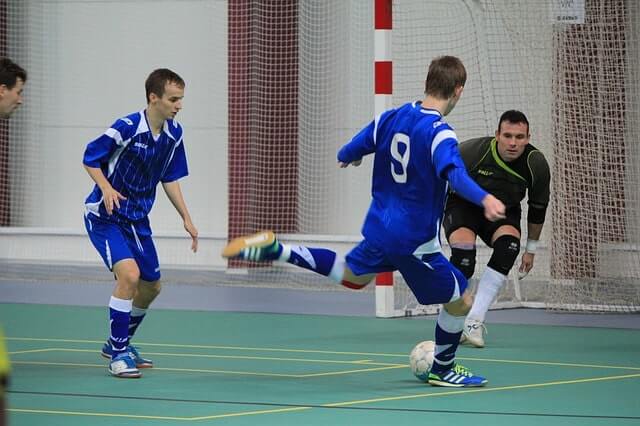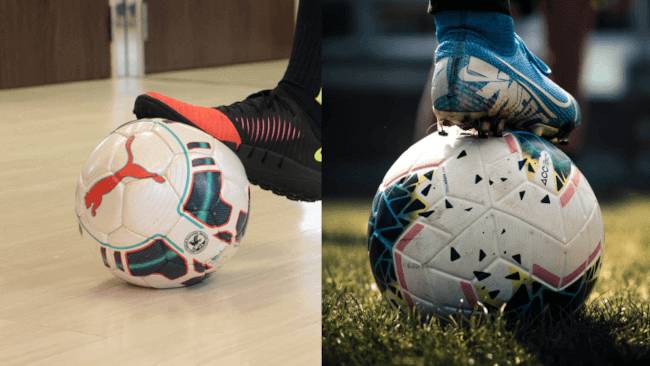Futsal is one of those sports that looks like soccer but in fact is different from soccer in many ways. Futsal is one of many other variations of the regular soccer game that we talk about on this blog.
While there are many differences between soccer and futsal that we can talk about, one of the major ones is the balls used in both games.
A futsal ball is different from a soccer ball in many ways… in 3 major ways actually, and we will be talking about each one of them in detail in this article.
But here’s your quick answer before we dive into the details:
A futsal ball is smaller in size than a regular soccer ball. A futsal ball is also less bouncy than a soccer ball due to the materials used inside each ball and other factors. Finally, and unlike the popular belief, the futsal ball usually has less weight than a soccer ball.
So that’s your answer right there. But for the readers who want to dive into more details when it comes to each of the mentioned differences between the 2 balls, then here are the details for you:
1- Futsal ball size vs soccer ball size.
In the world of soccer, there are a number of official ball sizes and each one of these sizes is identified by a number.
Here are the different ball sizes in soccer and their names:
| Name | Circumference | Preferred Age |
| Size 5 | 27-28 inch / 68-70 cm | 12 and older |
| Size 4 | 25-26 inch / 63.5-66 cm | Between 8 and 12 years old |
| Size 3 | 23-24 inch / 58.5-61 cm | 8 and younger |
| Size 1 | 18-20 inch / 46-51 cm | Any age |
Yes, for some reason, the Size 2 name is skipped. I have no idea why, but it is what it is.
Anyways, Soccer uses the size 5 ball while futsal uses the size 4 ball. In other words, a soccer ball is bigger than a futsal ball.
The soccer ball circumference is usually somewhere between 27-28 inches while a futsal’s ball circumference is somewhere between 25-26 inches.
Why is a bigger ball used in soccer?
Well, in soccer, having a large ball has its advantages, especially for the goalkeeper.
The soccer field is very large and the nets are also very large. For the goalkeeper to be able to catch the ball well or block it from entering the large net, the ball has to be a little bit large.
A large ball helps the goalkeepers handle high speed balls coming towards them in a much better way. For this, and for other reasons, a regular soccer ball is usually larger in size than the balls used in some other soccer variants like futsal for example.
In futsal, the need for a large ball isn’t very necessary, because the nets are relatively small thus the goalkeepers can manage even if the ball is a little bit small.
2- Futsal ball bounces less than a regular soccer ball
The futsal ball is made in a way that makes it less bouncy than a soccer ball. There are several factors that play a role in the bounciness of the ball including the inside materials of the ball and the air pressure for sure.
In general, futsal balls contain foam or cotton or any other material inside them that make them less bouncy and also make them a little bit softer.
As for the soccer ball, it bounces much more than a futsal ball. This makes the ball a little bit harder to trap and control.
Did you know that trapping the ball in futsal is easier than trapping it in soccer. Why? Simply because the futsal ball won’t bounce back away from you very easily when you are trapping it with your chest, thigh or with your foot.
On the other hand, the soccer ball is more bouncy which means that it is more likely to bounce away from you while you are attempting to stop it with one touch.
Why is the futsal ball made less bouncy?
If you think about it, making the futsal ball less bouncy makes a lot of sense. The futsal field is very small when compared to a standard sized soccer field.
The small size of the futsal field and the large number of players per team makes the field crowded with players.
This means that the futsal players do not have a lot of open spaces on the field. In other words, they will almost always have an opponent close enough to them.
If the futsal ball was bouncy in this situation, then the players will lose the ball a lot more since it has a higher probability of bouncing away from the players while they are trapping it.
And once it bounces away a little bit, an opponent player will almost always be around to steal the ball immediately.
So in simple words, making the futsal ball less bouncy helps the teams not lose the ball very frequently when the players are passing the ball to each other.
But there are no benefits without some drawbacks right?
It’s true that making the futsal ball less bouncy helps the players control it easier, however, the ball will be harder to kick.
A Futsal ball is harder to kick when compared to other balls. But again, this drawback does not affect the game a lot since the futsal players do not have to make the ball travel for long distances as in regular soccer.

3- Futsal ball weight vs soccer ball weight.
A popular belief in the soccer world is that the futsal ball is heavier than a soccer ball. However, this isn’t generally the case.
Let’s talk about numbers. A size 5 official soccer ball should usually have a weight between 14.4 oz (410 g) and 15.8 oz (450 g).
As for the futsal ball, it is a size 4 ball and it usually weighs somewhere between 14.1 oz (400 g) and 15.5 oz (440 g)
The 2 weight intervals overlap, however, the highest value in the weight interval of a soccer ball is higher than the one of the futsal ball.
In other words, while there are some futsal balls that weigh more than regular soccer balls, it is more often the case that the futsal balls weigh less than a soccer ball.
Why do many people think that a futsal ball weighs more than a soccer ball?
I believe the main reason behind this is how the ball feels when you are playing with it on the field.
Since the futsal ball is less bouncy, it feels heavy when it is being kicked. In addition to this, the futsal ball is dense since it has a small size but a relatively large weight so it feels heavy.
On the other hand, kicking the regular soccer ball can feel easier and thus some people might think that the soccer ball is lighter than the futsal ball when most of the time it isn’t.
CONCLUSION
Both the futsal ball and the soccer ball are designed in a way that makes them fit the game they represent, and since soccer and futsal have many differences, it only makes sense that the balls of each of these sports are made differently to fit the different requirements of each sport.
The size of the field, the size of the nets, the type of the team strategies and so on, are all factors that play a role in deciding the type of the ball to be used in each of the 2 mentioned sports.
With that said, we have reached the end of this article. If you would like to read more, you can check this article that discusses the similarities and differences between soccer and basketball.

